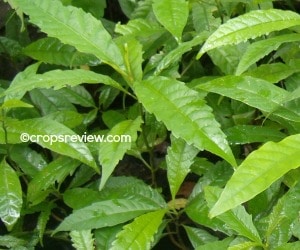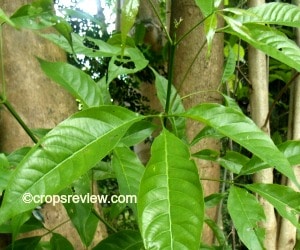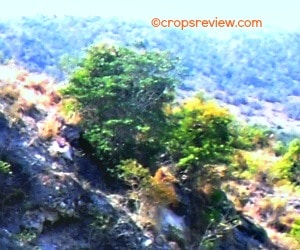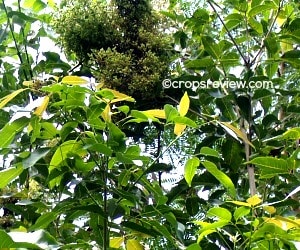I am quite familiar with the molave tree (Vitex parviflora Juss.), also called small-flower chaste tree, molawin, tugas, and many other vernacular names.
At least I am confident enough that I can identify the tree in any size, on field or on a pot, including stocked logs and posts, with respectable accuracy.
I’m likewise familiar with the two strains or types growing in the province of Sarangani and in General Santos City, Philippines, known locally as the tugas babae and the tugas lanhan.
However, whether the two are simply botanical variants of the same species or they are distinct species need further enlightenment from plant taxonomists.
In this paper and elsewhere in this site, the use of the term strain and type are merely for convenience and does not connote an expert determination of the issue.
Molave trees of the tugas babae type are well distributed in the SarGen area, with the exception of the southernmost barangays of General Santos City and the adjacent parts of Sarangani which are considered natural habitat of the tugas lanhan.
Both strains are commonly found growing on dry, limestone soils although they grow in any soil.
They also grow from crevices and small holes in limestone rocks.
Some appear to hang from the faces of limestone cliffs.
Both strains have very hard wood.
However, most residents in this area who are familiar with molave trees or wood, including me, are convinced that the tugas lanhan is much harder due to interlocking or wavy grains (grano) while the tugas babae has generally straight grains.
Mature molave trees have palmately compound leaves with three leaflets which arise from a common point in the petiole.
These leaves are arranged opposite on a node of the stem.
But the leaflets of the tugas babae are longer but narrower with pointed tips than those of the tugas lanhan.
It’s somewhat different in young plants.
The seedlings, particularly those of tugas babae, tend to have simple leaves consisting of a single leaf blade that is connected to a node by a petiole.
However, the margins (edges) of the leaflets in the tugas babae seedlings are clearly serrated (toothed like saw) while those in the tugas lanhan are entire (unserrated) or less serrated.
The tugas babae also tends to form relatively straighter trunk and branches than the tugas lanhan.
The former tends to grow upward fast with sparse branches, but the latter tends to form a spreading crown with crooked branches that are closely spaced.
The former seems to exhibit stronger apical dominance than the latter.
The word tugas is the Cebuanos’ generic name for the molave tree.
This common name is likewise used in Bikol, Masbate, Waray, and Kuyonon (Fernandez 1993).
But in Ilonggo, the word tugas is the equivalent of the Cebuanos’ “bahi”, referring to that portion of the stem of certain trees and palms which hardens as the plant matures.
Carpenters often complain of the difficulty in hammering nails straight through bahi.
 |  |
In trees the bahi is found on the inner wood (the heartwood).
It is distinguishable by its dark or black color compared to the light-colored outer wood (the sapwood) bordered by the bark.
But in old palms, it is that blackish portion between the bark and the soft tissue at the central part of the stem.
Tugas babae literally means female molave, which name confuses me because, to my knowledge, there is no tugas lalake or male molave.
The name is in fact misleading botanically because all molave trees, unlike papaya, are hermaphrodites with flowers that contain both the male and female sexual organs (such flowers are called perfect or bisexual).
I am not aware how the name evolved or why it is called such.
However, there are suggestions that the Filipino word babae, meaning woman or female, connotes being soft.
It is the same description (soft) that is commonly applied to the wood of tugas babae as contrasted to tugas lanhan.
 |  |
On the other hand, lanhan (short of lanahan) means containing oil or oily, from the vernacular rootword “lana” for oil.
Therefore, tugas lanhan literally means, in Cebuano, oily molave.
As specimen in bonsai, I treat the two strains as distinctly different.
The tugas lanhan can be rapidly induced to miniaturize with rugged, aged-looking bark, tapering trunk and branches without cutting marks, with shortened internodes and tiny leaves.
Size of leaflet can be reduced to about 1 cm (10 mm).
In contrast, the tugas babae always has smooth bark and it hardly responds to shortening of internodes and leaf miniaturization techniques.
Despite numerous attempts, I managed to reduce leaflet size to only about 2.5 cm (1 in) in length.
Wounds on the trunk and cuts on the branches tend to induce rapid outward growth forming mump-like projections.
LITERATURE CITED
FERNANDEZ PG (ed.). 1993. Agroforestry Species in the Philippines: Common Names, Seed Sources, and Growth Requirements. Agroforestry Seeds Circular No. 3 Supplement. UPLB, Laguna, PH: AFSICH. 20 p.
Click to read more:
/ Molave: Botany and Growth / Propagation by Wildlings and Stem Cuttings /
